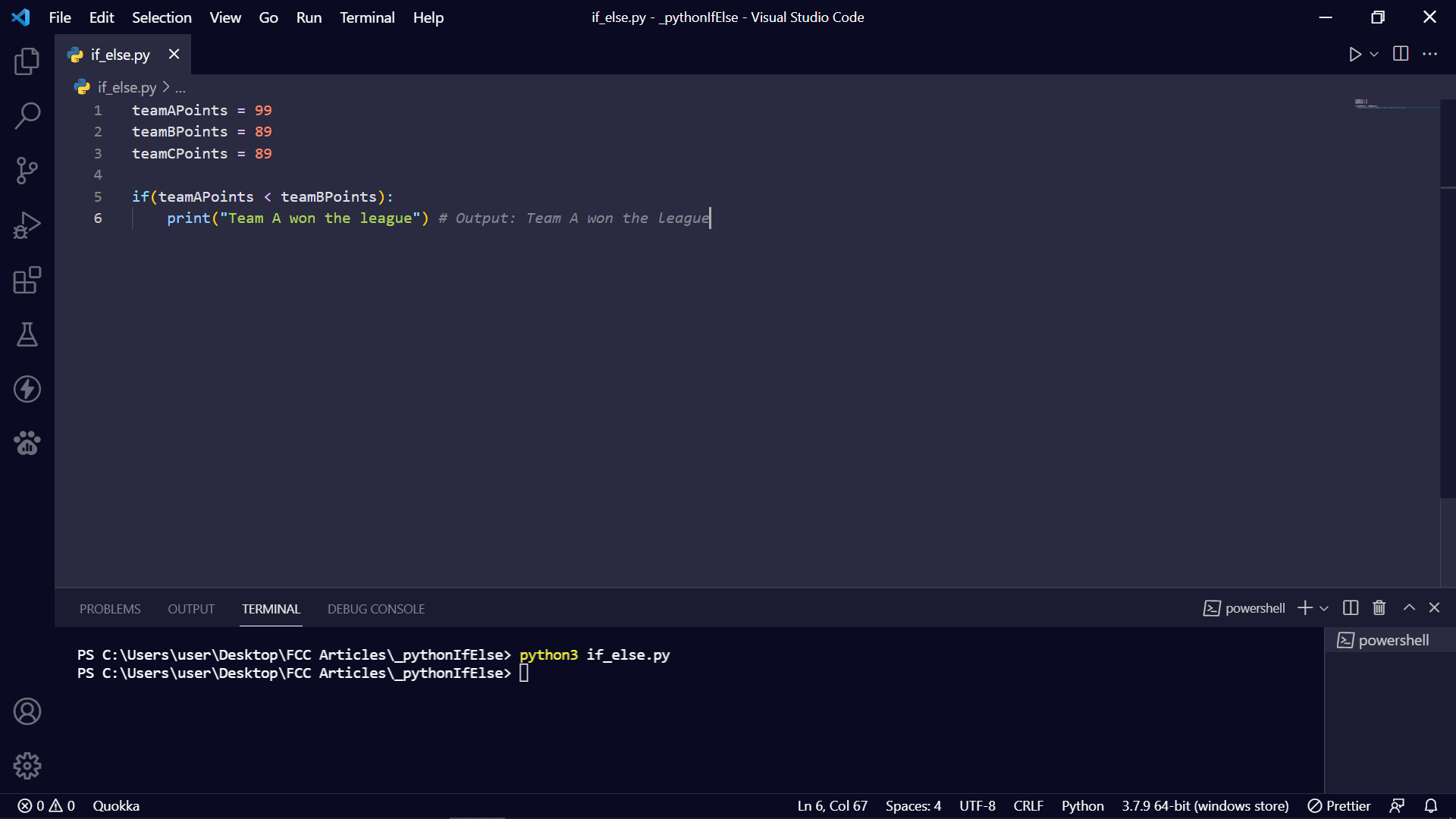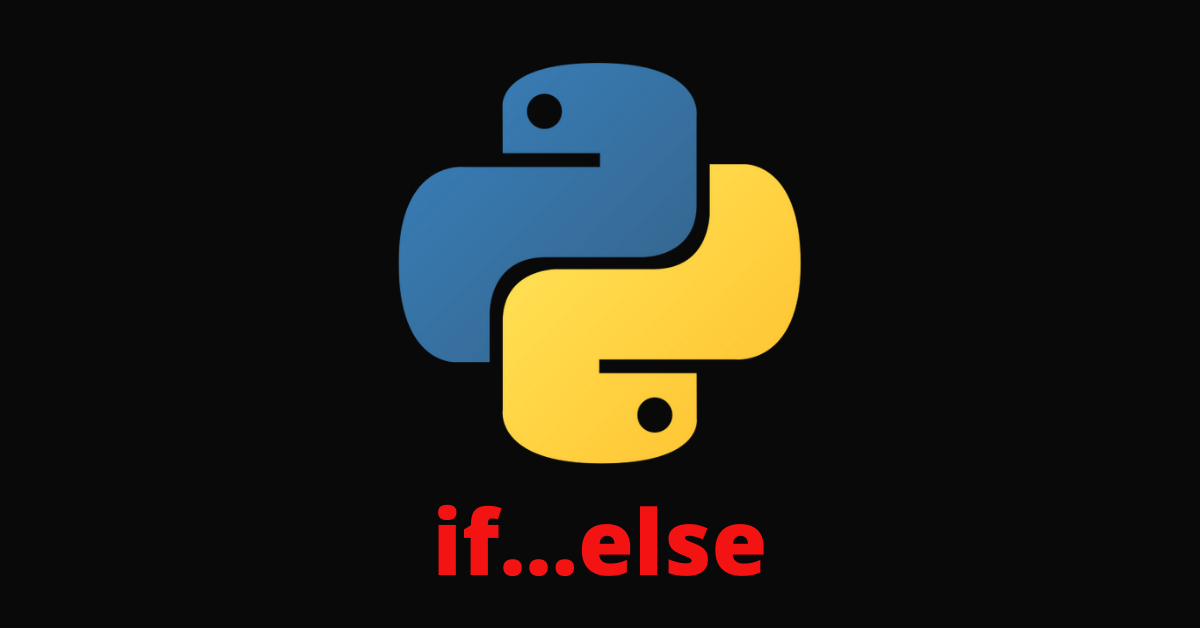In your applications and web projects, there might be times when a user needs to perform an action if a certain condition is met.
There might also be cases when you need to make the user perform another action if the condition is not met.
To do this in Python, you use the if and else keywords. These two keywords are called conditionals.
In this article, I will show you how to implement decision making in your applications with the if and else keywords. I will also show you how the elif keyword works.
I will be using Python comparison operators such as > (greater than), < (less than), and (==) equals to compare variables in the if and elif blocks, so we can make the decisions.
How to Use the if Keyword in Python
In Python, the syntax for a single if statement looks like this:
if(condition):
indented block of decision to make if condition is true
Unlike some other programming languages which use braces to determine a block or scope, Python uses a colon (:) and indentation (4 whitespaces or a tab).
So, the indented line or lines of code after the colon will be executed if the condition specified in the braces in front of the if keyword is true.
In the example below, I'm recording the points of 3 soccer teams in 3 variables and making a decision with an if statement.
teamAPoints = 99
teamBPoints = 89
teamCPoints = 89
if(teamAPoints > teamBPoints):
print("Team A won the league") # Output: Team A won the league
You can see that the code ran because the condition – teamAPoints > teamBPoints – was met. That is, Team A won the league because they had 99 points as compared to Team B and Team C.
Python has the and keyword that can help us bring Team C into the comparison:
teamAPoints = 99
teamBPoints = 89
teamCPoints = 89
if(teamAPoints > teamBPoints and teamCPoints):
print("Team A won the league against Team B and Team C") # Output: Team A won the league against Team B and Team C
The code ran again because the condition – teamAPoints > teamBPoints and teamCPoints – was met.
If you have only one block of code to execute with the if statement, you can put it in one line and everything would still be okay, as shown below:
teamAPoints = 99
teamBPoints = 89
teamCPoints = 89
if(teamAPoints > teamBPoints): print("Team A won the league") # Output: Team A won the league
This is not a rule, it’s just common practice.
If the condition in the if statement is not met, nothing happens.
In the screenshot below, nothing happens because the condition specified in the if statement is not true. Team A has more points (99) than Team B (89).

By the way, you run Python code in the terminal by typing Python or Python3 followed by the file name, the .py extension, and then hit ENTER on your keyboard. For example, python3 if_else.py.
How to Use the else Keyword in Python
Since nothing happens if the condition in an if statement is not met, you can catch that with an else statement.
With else, you make the user perform an action if the condition in the if statement is not true, or if you want to add more options.
The syntax for if...else is an extension from that of if:
if(condition):
indented block of decision to make if condition is true
else:
indented block of decision to make if condition is not true
In the code snippet below, the block of code in the else scope runs because the condition specified is not true – Team C doesn’t have more points than Team A.
teamAPoints = 99
teamBPoints = 89
teamCPoints = 89
if(teamCPoints > teamAPoints):
print("Team C won the league")
else:
print("Team A won the league") # Output: Team A won the league
If you have only one block of code to execute with the if and one with the else, you can put it in one line and everything would still be okay:
teamAPoints = 99
teamBPoints = 89
teamCPoints = 89
if(teamCPoints > teamAPoints): print("Team C won the league")
else: print("Team A won the league") # Output: Team A won the league
Nested if in Python
You can combine what if...else does into a single if statement. This is called nesting in programming languages.
The syntax for nesting 2 or more if statements looks like what you see in the code snippet below:
if(condition):
if(condition):
if(condition)
indented block of decision to make
In nested if, all the conditions must be true for the code to run.
teamAPoints = 99
teamBPoints = 89
teamCPoints = 88
if (teamAPoints > teamBPoints):
if (teamAPoints >= teamBPoints):
if (teamAPoints >= teamCPoints):
print("Team A won the league") # Team A won the league
How to Use the elif keyword in Python
Another conditional keyword in Python is elif, which you can put in between an if and else.
In the snippet of code below, you can see how the elif keyword works:
teamAPoints = 99
teamBPoints = 89
teamCPoints = 88
if (teamAPoints == 89):
print("Team B did not win the league")
elif(teamAPoints == 99):
print("Team A won the league")
else:
print("Team C won the league") # Result: Team A won the league
The condition in the if statement did not run because Team A has 99 points
The condition in the elif is true and ran because Team A has 99 points, so the else block was ignored.
Conclusion
In this article, you learned about if…else in Python so you can implement conditionals in your projects.
Thank you for reading, and happy coding.

